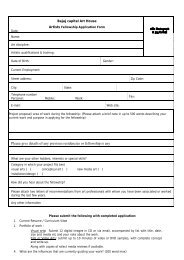download - Art Positive
download - Art Positive
download - Art Positive
Create successful ePaper yourself
Turn your PDF publications into a flip-book with our unique Google optimized e-Paper software.
man. In that sense itself Sai Baba’s life which evoked faith and devotion in the minds of the faithful<br />
presents an argument and inspiration for leading the good human life.<br />
Sai Baba’s birth and life have become to millions a symbol of a life free from individual attachments,<br />
religious commitments and ideological constraints. The very first fact of freedom was his freedom<br />
from a name. This was no small fact. For in India in the late 1800’s and early1900’s a name was<br />
the multiple marker of identity: place in social hierarchy, status, occupation, caste, religion etc. Sai<br />
Baba, even before he came to be recognized as a saint, was not identified by any such reference<br />
to his family, social heritage etc. He was Indian and he was a human being. This however led to no<br />
identity crisis but to a life in which the early years were spent like a yogi in gaining self realization<br />
and the later years were spent in imparting such knowledge of the self to his devotees. There exists<br />
very little verifiable information about the early life of Sai Baba about his individual identity, his<br />
parentage, family, caste, region or religion. In contrast a relatively larger corpus of information is<br />
available about his life in Shirdi especially after 1910. The most important source of information<br />
about the life of Sai Baba of Shirdi is Sri Sai Saccarita a devotional biography in Marathi by Govind<br />
Raghunath Dadholkar. This book pertains to events and miracles which the author witnessed himself<br />
in the last eight years of the saint’s life in Shirdi, that is, between 1910 and 1918. What is most<br />
important about this text is that its preparation began with the full approval of Sai Baba who himself<br />
blessed the undertaking. The book was published eleven years after Sai Baba died that is in 1929.<br />
The English translation of this book with the title Sri Sai Satcharita was published much later in 1944.<br />
There is some dispute among scholars as to whether this book is a verbatim translation of the earlier<br />
work though it claims to be so. The Shri Sai Satcharita clarifies that Sai Baba suddenly appeared in<br />
Shirdi at about the age of sixteen and stayed there for three years. After that he disappeared for some<br />
time. He reappeared in Aurangabad and came to Shirdi again with the marriage party of Chand Patil<br />
when he was about twenty years old. He stayed in Shirdi after that for about sixty years and took<br />
mahasamadhi in the year 1918.<br />
The years in which he lived were years in which the Indian politics was both, colonized and, internally<br />
divided along lines of caste, creed and religion. Perhaps the second fact of Sai Baba’s freedom came<br />
from being a saint without a clear commitment to any one organized religions. Baba, it could be<br />
said fairly, was free of any commitment to an organized sectarian religion for it was impossible to<br />
say if he was a Hindu or a Muslim. The 1961 census of India reported that “no one knew whether<br />
he was a Hindu or Muslim”. [1] He lived in a mosque and spent most of his life sitting by its wall. His<br />
mantra was Allah Maalik or God is the Master. On the festival of Id he permitted Muslims to say their<br />
prayers at his mosque. Once he permitted the keeping of the tabut [2] at his masjid for four days during<br />
a Mohurrum festival. He got it removed without demur on the fifth day. He distributed food to the<br />
poor as prasada. In this exercise called a bhandara he himself cooked and served non vegetarian<br />
and vegetarian food to members of both religious groups. Yet he discoursed on the Bhagavad Gita<br />
as noted above. He advised his devotee Kaka Saheb Dixit to read daily two works of Shri Eknath:<br />
Bhagawat and Bhavartha Ramayana. In terms of his discussions with orthodox Hindu followers he<br />
seemed to possess considerable knowledge of Vedanta. In his leelas he is recorded as frequently<br />
referring to the karma of past lives and the transmigration of souls. Sai Baba was adept at many yogic<br />
practices. He was well versed in six processes including Dhauti (stomach cleaning), Khandayog<br />
(separating his limbs and joining them again) and Samadhi (meditation) etc. He had a dhuni or<br />
sacred fire burning at all times in the masjid. He did various things contrary to the Muslim religion:<br />
blowing of the conch and bells, oblation in the fire, singing of bhajans, giving of food as prasada<br />
to devotees, and permitting devotees to worship him at his feet by means of water (arghya) etc. He<br />
99




